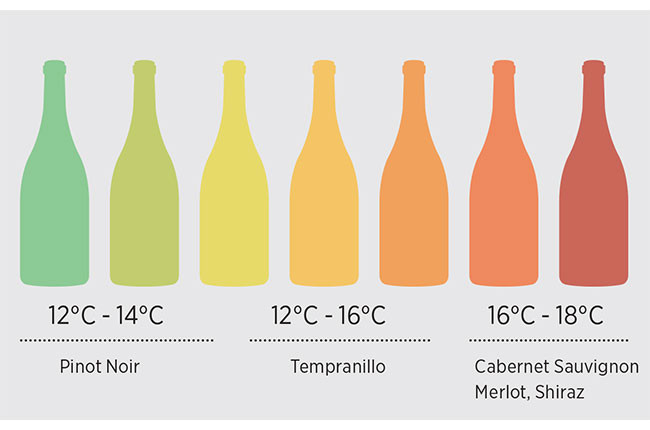Serving red wine at the right temperature can be the key to unlocking its full potential and enhancing your drinking experience. For too long, the ambiguous concept of “room temperature” has been the standard recommendation. However, in our modern, centrally heated homes, this guideline often leads to red wines being served too warm, compromising their delicate flavors. Let’s delve into the ideal temperature to serve red wine and how to ensure you’re getting it just right.
The Myth of “Room Temperature”
The phrase “room temperature” as a wine serving guideline evokes images of old European castles with naturally cool cellars. Historically, room temperature in these settings was significantly cooler than what we consider room temperature today.
Consider this: the average UK household temperature in 1966 was around 12°C (54°F). Fast forward to today, and the average temperature sits closer to 18°C (64°F), and even higher in many US homes where thermostats are often set around 20°C (68°F). These modern “room temperatures” are actually at the upper end, or even exceed, the recommended serving temperatures for many red wines. Therefore, relying on “room temperature” in the 21st century can lead to serving red wine too warm, detracting from its intended taste profile.
Why Serving Red Wine Too Warm Hurts the Taste
When red wine is served too warm, several negative changes occur that impact the overall drinking experience. The most prominent issue is the accentuation of alcohol. Excess heat emphasizes the ethanol, creating a “hot” or burning sensation, similar to the harshness of spirits. This overbearing alcohol note overshadows the wine’s more nuanced characteristics.
Furthermore, the vital freshness and acidity that provide balance to a red wine’s fruit and body become muted at warmer temperatures. These elements, crucial for structure and vibrancy, are suppressed, leading to a wine that can feel heavy, flat, and even “soupy.” While taste is subjective, these characteristics are generally considered undesirable in a well-balanced red wine. Many have likely encountered an overly warm, lackluster red wine, perhaps in a hot climate or a restaurant lacking proper wine storage.
Embracing the Chill: Serving Red Wine Cooler
While serving red wine too warm is a common mistake, serving it slightly chilled, especially for lighter styles, can be remarkably beneficial. Lighter-bodied red wines, particularly those with minimal or no oak aging, often shine when served at cooler temperatures. Think of varieties from cooler climates like Pinot Noir, Gamay (Beaujolais), Schiava, and Zweigelt.
Wine expert Peter Richards MW, writing for Decanter, suggests that “good summer reds should be served at 10°C-16°C (50°F-60°F).” He even advises, “don’t be afraid to pop them in the fridge for 30 minutes before serving,” to achieve these lower temperatures, especially on warmer days.
Generalizing about wine temperatures can be tricky due to diverse winemaking styles. However, wines like Beaujolais (Gamay) and Valpolicella Classico (Corvina) are classic examples of reds that are often best enjoyed at the cooler end of the spectrum.
The graphic below illustrates the spectrum of red wine body styles and their corresponding ideal serving temperatures, highlighting how lighter wines like Pinot Noir benefit from cooler temperatures, while fuller-bodied wines still require a slightly warmer range.
 Red Wine Temperature Guide: Serving temperatures for light, medium, and full-bodied red wines, including Pinot Noir, Rioja, Cabernet Sauvignon, and Syrah/Shiraz.
Red Wine Temperature Guide: Serving temperatures for light, medium, and full-bodied red wines, including Pinot Noir, Rioja, Cabernet Sauvignon, and Syrah/Shiraz.
Finding the Perfect Serving Temperature for Red Wine
For precise temperature control, a wine fridge is an invaluable tool. However, a simple wine thermometer can also be very effective. Knowing your ambient room temperature is also helpful in gauging how quickly your wine might warm up after pouring.
Ultimately, trust your palate. As sommelier Xavier Rousset wisely noted, “I can’t recall the last time I used a thermometer either at home or in a professional environment.” Beyond obvious wine faults, the key is balance. If a red wine tastes too warm and alcoholic, a brief chill can improve it dramatically. Conversely, if it seems too closed or austere, gently warming the glass in your hands can help it open up.
Keep in mind that wine temperature evolves in the glass. A Bordeaux served at 18°C (64°F) can quickly reach 22°C (72°F) or higher depending on the environment. Maintaining the ideal temperature throughout consumption is arguably the most challenging aspect of serving red wine perfectly. Experiment, taste, and adjust – your palate is the best guide to finding the optimal Temp To Serve Red Wine and maximizing your enjoyment.
